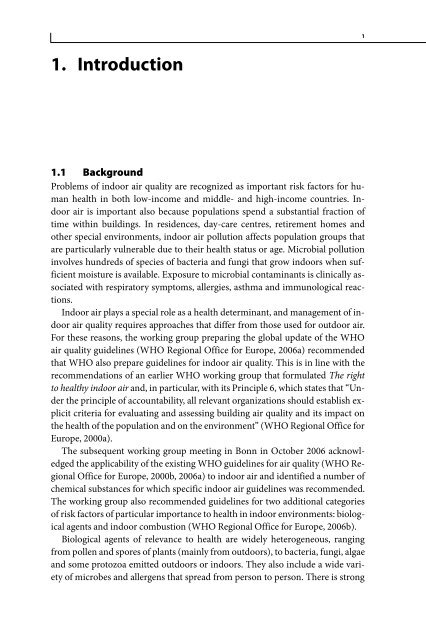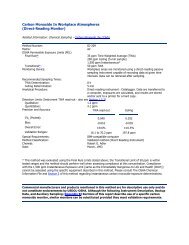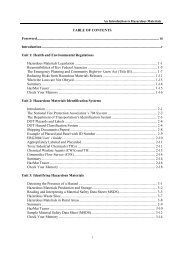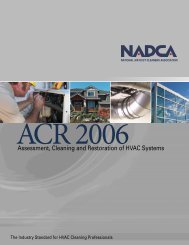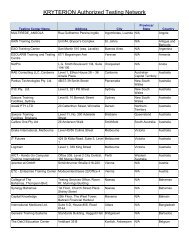Dampness and Mould - WHO guidelines for indoor air quality - PRWeb
Dampness and Mould - WHO guidelines for indoor air quality - PRWeb
Dampness and Mould - WHO guidelines for indoor air quality - PRWeb
Create successful ePaper yourself
Turn your PDF publications into a flip-book with our unique Google optimized e-Paper software.
1<br />
1. Introduction<br />
1.1 Background<br />
Problems of <strong>indoor</strong> <strong>air</strong> <strong>quality</strong> are recognized as important risk factors <strong>for</strong> human<br />
health in both low-income <strong>and</strong> middle- <strong>and</strong> high-income countries. Indoor<br />
<strong>air</strong> is important also because populations spend a substantial fraction of<br />
time within buildings. In residences, day-care centres, retirement homes <strong>and</strong><br />
other special environments, <strong>indoor</strong> <strong>air</strong> pollution affects population groups that<br />
are particularly vulnerable due to their health status or age. Microbial pollution<br />
involves hundreds of species of bacteria <strong>and</strong> fungi that grow <strong>indoor</strong>s when sufficient<br />
moisture is available. Exposure to microbial contaminants is clinically associated<br />
with respiratory symptoms, allergies, asthma <strong>and</strong> immunological reactions.<br />
Indoor <strong>air</strong> plays a special role as a health determinant, <strong>and</strong> management of <strong>indoor</strong><br />
<strong>air</strong> <strong>quality</strong> requires approaches that differ from those used <strong>for</strong> outdoor <strong>air</strong>.<br />
For these reasons, the working group preparing the global update of the <strong>WHO</strong><br />
<strong>air</strong> <strong>quality</strong> <strong>guidelines</strong> (<strong>WHO</strong> Regional Office <strong>for</strong> Europe, 2006a) recommended<br />
that <strong>WHO</strong> also prepare <strong>guidelines</strong> <strong>for</strong> <strong>indoor</strong> <strong>air</strong> <strong>quality</strong>. This is in line with the<br />
recommendations of an earlier <strong>WHO</strong> working group that <strong>for</strong>mulated The right<br />
to healthy <strong>indoor</strong> <strong>air</strong> <strong>and</strong>, in particular, with its Principle 6, which states that “Under<br />
the principle of accountability, all relevant organizations should establish explicit<br />
criteria <strong>for</strong> evaluating <strong>and</strong> assessing building <strong>air</strong> <strong>quality</strong> <strong>and</strong> its impact on<br />
the health of the population <strong>and</strong> on the environment” (<strong>WHO</strong> Regional Office <strong>for</strong><br />
Europe, 2000a).<br />
The subsequent working group meeting in Bonn in October 2006 acknowledged<br />
the applicability of the existing <strong>WHO</strong> <strong>guidelines</strong> <strong>for</strong> <strong>air</strong> <strong>quality</strong> (<strong>WHO</strong> Regional<br />
Office <strong>for</strong> Europe, 2000b, 2006a) to <strong>indoor</strong> <strong>air</strong> <strong>and</strong> identified a number of<br />
chemical substances <strong>for</strong> which specific <strong>indoor</strong> <strong>air</strong> <strong>guidelines</strong> was recommended.<br />
The working group also recommended <strong>guidelines</strong> <strong>for</strong> two additional categories<br />
of risk factors of particular importance to health in <strong>indoor</strong> environments: biological<br />
agents <strong>and</strong> <strong>indoor</strong> combustion (<strong>WHO</strong> Regional Office <strong>for</strong> Europe, 2006b).<br />
Biological agents of relevance to health are widely heterogeneous, ranging<br />
from pollen <strong>and</strong> spores of plants (mainly from outdoors), to bacteria, fungi, algae<br />
<strong>and</strong> some protozoa emitted outdoors or <strong>indoor</strong>s. They also include a wide variety<br />
of microbes <strong>and</strong> allergens that spread from person to person. There is strong


